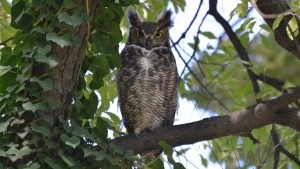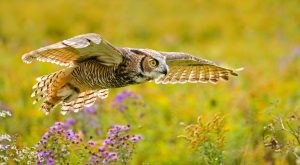This content was originally published by the Longmont Observer and is licensed under a Creative Commons license.
I’ve been seeing reports of people hearing owls calling in their backyards, so I thought it might be a good time to write about owls. I chose great-horned owls because they are starting to call for mates right now and they are probably the most recognizable owl for most people. Also, we have them right here in town.
Great-horned owls are the largest of all the tufted owl species. As mentioned, the most noticeable feature of great-horned owls are their ear tufts. The tufts are an arrangement of feathers called a plumicorn. Although they do not help the owl with hearing, they can change position from erect to flattened depending on the mood of the owl. Great-horned owls are a mottled greyish-brown color.

Their underside is barred, their faces are reddish brown, and they have a white throat patch. The overall color can vary from brown, gray, or black and white. Great-horned owls have large yellow eyes; in fact, they have the largest eyes of all the owl species. Their eyes do not move in the sockets, but great-horned owls are capable of rotating their heads up to 270 degrees. Their eyesight is 10 times better than humans in the daytime and 100 times better at night. Great-horned owls have feathered feet and special feather adaptations that allow them to fly silently, greatly aiding in nighttime hunting. One such adaptation is the presence of sound-lessening filaments at the tips of their feathers.
Great-horned owls can be found in wooded areas that border open areas such as fields. However, they are equally comfortable in urban settings and can be seen in backyards and parks. Great-horned owls are common throughout the United States, and are found in a variety of habitats throughout.

Great-horned owls are nocturnal birds, but they will hunt during the day, especially when young are present or during the winter. They have acute hearing thanks to facial disc feathers that help direct sound toward their ears. This, combined with their silent flight, allows them to swoop down and surprise their prey. Great-horned owls eat a wide variety of prey from mice to other raptors. They eat primarily mammals and birds, but they will also eat reptiles, invertebrates, fish, insects, and sometimes dead animals. Great-horned owls use their talons to sever the spine of their prey. Research shows that it takes 28 pounds of force to open an owl’s talons once they are closed. In the northern parts of the United States, great-horned owls may store their prey, thawing it out by “incubating” it when they are ready to eat.
Male great-horned owls begin calling for mates as early as December and January in Colorado. During courtship, the male approaches the female, bowing and hooting and puffing up the white throat patch. The female then calls back to the male. Male and female hoots are at different pitches and can be distinguished from each other because the female’s voice is higher pitched. The pair engages in a series of calling called duetting and bow to each other with their wings drooped. Researchers have found that pairs also engage in giggling, screaming, and bill-snapping. Great-horned owls appear to be monogamous and have been known to stick with a mate for at least five years, but there are relatively few data on the longevity of the pair bond.
Great-horned owls use the abandoned nests of other large birds or squirrels that are 15-70 feet above the ground. What the nest consists of depends on the species that built it, but many nests consist of sticks. Great-horned owls may line the nest with fur, feathers plucked from their breast, shreds of bark, or leaves. Nests are rarely used again the following year because no maintenance is performed on the nest throughout the nesting season.

Female great-horned owls lay one to six dull white eggs, although the average clutch size is two or three eggs. Typically, the first egg laid will be the largest with size diminishing as subsequent eggs are laid. The female incubates the eggs for 25-38 days while the male brings her food throughout the night. The young are born helpless with closed eyes. The female broods them while the male brings food to the nest for about two weeks, at which time both members of the pair bring food. By day 8-11, the eyes open. At five weeks after hatching, the owlets begin to leave the nest and crawl around on adjacent tree branches. At around 9-10 weeks, owlets begin to fly. After fledging, owlets remain near their parents throughout the summer. Fledglings will leave their parents in the fall.
During the day, look for large flocks of agitated crows. They may be mobbing a great-horned owl. At night, you can listen for their hoots that sound like hoo-h’HOO-hoo-hoo. If you are lucky, you will spot one of these big birds in your yard.


